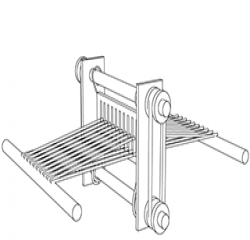Danqing Wang
Kristina Budelis
Pamela Liou
Tan Ma
Weavey, the Smart Loom
Weavey allows the user to design and generate complicated patterns with ease, marrying handcraft with technology.
http://pamelaliou.com/blog/?p=169

Classes
Introduction to Physical Computing
Introduction to Physical Computing
Weavey is a “smart loom” that allows the user to enjoy weaving without having to worry about the keeping track of a pattern. The tabletop loom operates with a 3-shaft heddle that lifts and lowers using stepper motors. Steppers rotate either clockwise or counterclockwise, lifting and lowering the heddle cards respectively. The heddle cards contain the “program” that addresses which threads are lifted/lowered.
The logic behind the stepper movements is controlled with an Arduino Uno which uses serial communication to talk to Processing.
The user will use an application written in Processing in order to design their weave pattern. The available patterns depend on how the cards are printed.
Background
We researched heddle looms, toy looms like the classic Brio design , and heddle lifting mechanisms.
Audience
Any weavers, particularly those who are new to weaving and want to lower barrier of entry.
User Scenario
The user will input a pattern through our processing sketch. Once they press "ready" on the sketch, they will begin to weave. Weaving will be a swifter, easier experience because of the automated heddle lifts.
Implementation
The body of the loom is built from laser cut masonite. The mechanism is a timing pulley. The connection between the heddle beams and the pulley is a combination of 3D printed ends, radial ball bearings, and steel timing pulleys.
Conclusion
Mechanisms do not allow for much deviation. Leveling everything for rotation requires a lot of rigor-- the beam cannot wobble. Connecting the heddle beam to the pulley was challenging for this reason. Thank god for 3D printing, which allows us to achieve pretty exact dimensions for fitting the components together.
Another lesson we learned was in interface design. Weaving is difficult for the uninitiated to wrap your mind around. We realized that we needed to walk the user through the process of weaving through clearer and more visual prompts.
The logic behind the stepper movements is controlled with an Arduino Uno which uses serial communication to talk to Processing.
The user will use an application written in Processing in order to design their weave pattern. The available patterns depend on how the cards are printed.
Background
We researched heddle looms, toy looms like the classic Brio design , and heddle lifting mechanisms.
Audience
Any weavers, particularly those who are new to weaving and want to lower barrier of entry.
User Scenario
The user will input a pattern through our processing sketch. Once they press "ready" on the sketch, they will begin to weave. Weaving will be a swifter, easier experience because of the automated heddle lifts.
Implementation
The body of the loom is built from laser cut masonite. The mechanism is a timing pulley. The connection between the heddle beams and the pulley is a combination of 3D printed ends, radial ball bearings, and steel timing pulleys.
Conclusion
Mechanisms do not allow for much deviation. Leveling everything for rotation requires a lot of rigor-- the beam cannot wobble. Connecting the heddle beam to the pulley was challenging for this reason. Thank god for 3D printing, which allows us to achieve pretty exact dimensions for fitting the components together.
Another lesson we learned was in interface design. Weaving is difficult for the uninitiated to wrap your mind around. We realized that we needed to walk the user through the process of weaving through clearer and more visual prompts.

